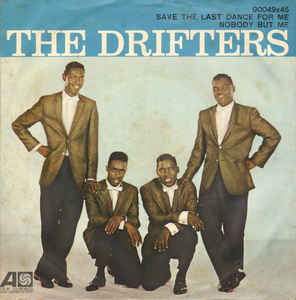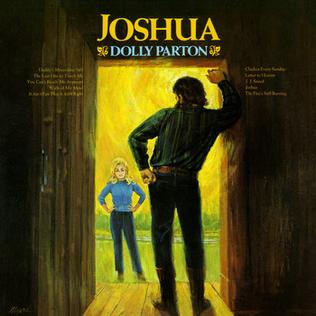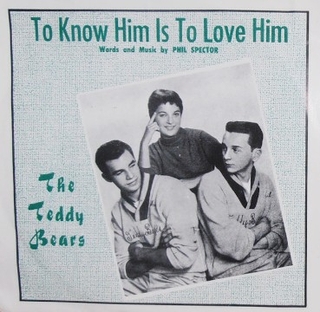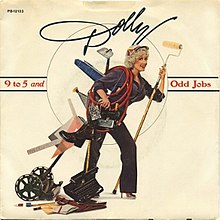
"I Will Always Love You" is a song written and originally recorded in 1973 by American singer-songwriter Dolly Parton. Written as a farewell to her business partner and mentor Porter Wagoner, expressing Parton's decision to pursue a solo career, the country single was released in 1974. The song was a commercial success for Parton, twice reaching the top spot of the US Billboard Hot Country Songs chart: first in June 1974, then again in October 1982, with a re-recording for The Best Little Whorehouse in Texas soundtrack.

"Islands in the Stream" is a song written by the Bee Gees and recorded by American country music artists Kenny Rogers and Dolly Parton. It was released in August 1983 as the first single from Rogers's fifteenth studio album Eyes That See in the Dark. The Bee Gees released a live version in 1998 and a studio version in 2001.

"Mr. Sandman" is a popular song written by Pat Ballard and published in 1954. It was first recorded in May of that year by Vaughn Monroe & his orchestra and later that year by The Chordettes and the Four Aces. The song's lyrics convey a request to "Mr. Sandman" to "bring me a dream" – the traditional association of the folkloric figure. The pronoun used to refer to the desired dream is often changed depending on the sex of the singer or group performing the song, as the original sheet music publication, which includes male and female versions of the lyrics, intended.

Here You Come Again is the nineteenth solo studio album by American entertainer Dolly Parton. It was released on October 3, 1977, by RCA Victor. The album was a commercial success, peaking at number 20 on the US Billboard 200 and at number 2 on the Hot Country Albums chart and also being nominated for Favourite Country Album at the American Music Awards. It became Parton's first album to be certified platinum by the Recording Industry Association of America for shipping a million copies. The lead single and title track was also a success, entering the top five of the US Billboard Hot 100 and being nominated for Favourite Country Single at the American Music Awards.

Trio is a collaborative album by American singers Dolly Parton, Linda Ronstadt, and Emmylou Harris. It was released on March 2, 1987, by Warner Bros. Records. The album has platinum certification in the U.S. for sales of one million copies, and has total worldwide sales of approximately four million. A second collaborative album, Trio II, was released in 1999.

"9 to 5" (or "Morning Train") is a song by Sheena Easton from 1981 album Take My Time. It was written by British songwriter Florrie Palmer and recorded and released as single in 1980, becoming Easton's biggest hit. It peaked at number three in the United Kingdom in August 1980 and was certified gold. In February 1981, it was released in the United States and Canada under the title "Morning Train (Nine to Five)" to avoid confusion with Dolly Parton's recent hit "9 to 5". It reached number one in both countries, becoming Easton's only chart-topper in those nations.

Coat of Many Colors is the eighth solo studio album by American singer-songwriter Dolly Parton. It was released on October 4, 1971, by RCA Victor. The album was nominated for Album of the Year at the 1972 CMA Awards. It also appeared on Time magazine's list of the 100 Greatest Albums of All Time and at No. 257 on Rolling Stone's 2020 list of the 500 Greatest Albums of All Time. Parton has cited the title track on numerous occasions as her personal favorite of all the songs she has written.

"Celebration" is a 1980 song by American band Kool & the Gang. Released as the first single from their twelfth album, Celebrate! (1980), it was the band's first and only single to reach No. 1 on the US Billboard Hot 100.

Heartbreaker is the twentieth solo studio album by American singer-songwriter Dolly Parton. It was released on July 17, 1978, by RCA Victor. The album was produced by Gary Klein and Parton with Charles Koppelman serving as executive producer, and was an even more direct aim at the pop charts, with several of its songs verging on disco. The album topped the Billboard Top Country Albums chart for nine consecutive weeks and peaked at number 27 on the Billboard 200. The album produced two number one hits on the Billboard Hot Country Songs chart, "Heartbreaker" and "I Really Got the Feeling", while "Baby I'm Burnin'" peaked at number 25 on the Billboard Hot 100. The album has been certified Gold in the United States and Canada.

Great Balls of Fire is the twenty-first solo studio album by American singer-songwriter Dolly Parton. It was released on May 28, 1979, by RCA Victor. The album was produced by Dean Parks and Gregg Perry with Parton and Charles Koppelman serving as executive producers. The album peaked at number four on the Billboard Top Country Albums chart and number 40 on the Billboard 200. Two of the album's four singles charted in the top ten of the Billboard Hot Country Songs chart. "You're the Only One" topped the chart, while "Sweet Summer Lovin'" peaked at number seven. The album has been certified Gold in the United States.

All I Can Do is the seventeenth solo studio album by American singer-songwriter Dolly Parton. It was released on August 16, 1976, by RCA Victor. The album was co-produced by Parton and Porter Wagoner and would be the last of Parton's solo albums to have any involvement from Wagoner. It was nominated for Best Country Vocal Performance, Female at the 19th Annual Grammy Awards. The album spawned three singles: "Hey, Lucky Lady", "All I Can Do", and "Shattered Image".

Dolly is the sixteenth solo studio album by American entertainer Dolly Parton. It was released on September 15, 1975, by RCA Victor. To differentiate it from Parton's 2009 4-disc, career-spanning box set, which is also titled Dolly, the album is sometimes referred to as Dolly: The Seeker – We Used To.

The Best of Dolly Parton is a compilation album by American singer-songwriter Dolly Parton. It was released on November 9, 1970, by RCA Victor. The album was produced by Bob Ferguson. It includes some of Parton's early hits, a few non-single album tracks, and two previously unreleased tracks. The album peaked at number 12 on the Billboard Top Country Albums chart. The single, "Mule Skinner Blues " peaked at number three on the Billboard Hot Country Songs chart and earned Parton a nomination for Best Female Country Vocal Performance at the 13th Annual Grammy Awards. The album was certified Gold by the RIAA on June 12, 1978, for sales of 500,000 copies.

"Save the Last Dance for Me" is a song written by Doc Pomus and Mort Shuman, first recorded in 1960 by American musical group the Drifters with Ben E. King on lead vocals. It has since been covered by several artists, including Dalida, the DeFranco Family, Emmylou Harris, Dolly Parton, and Michael Bublé.

Joshua is the seventh solo studio album by American singer-songwriter Dolly Parton. It was released on April 12, 1971, by RCA Victor. The album was produced by Bob Ferguson. It peaked at number 16 on the Billboard Top Country Albums chart and number 198 on the Billboard 200 chart. The album's single, "Joshua", was nominated for a Grammy and was Parton's first song to reach number one on the Billboard Hot Country Songs chart.

"Jolene" is a song written and recorded by American country music artist Dolly Parton. It was produced by Bob Ferguson and recorded at RCA Studio B in Nashville, Tennessee on May 22, 1973, then released on October 15, 1973 by RCA Victor as the first single and title track from her album of the same name.

"Here You Come Again" is a song written by Barry Mann and Cynthia Weil, and recorded by American entertainer Dolly Parton. It was released as a single in September 1977 as the title track from Parton's album of the same name, topped the U.S. country singles chart for five weeks, and won the 1978 Grammy award for Best Female Country Vocal Performance; it also reached number three on the U.S. Billboard Hot 100, representing Parton's first significant pop crossover hit.

"To Know Him Is to Love Him" is a song written by Phil Spector, inspired by words on his father's tombstone, "To Know Him Was to Love Him." It was first recorded by the only vocal group of which he was a member, the Teddy Bears. Their recording spent three weeks at No. 1 on the Billboard Hot 100 chart in 1958, while reaching No. 2 on the UK's New Musical Express chart. Peter & Gordon and Bobby Vinton later had hits with the song, with its title and lyrics changed to "To Know You Is to Love You". In 1987, the song was resurrected by Dolly Parton, Linda Ronstadt, and Emmylou Harris, whose Trio recording topped the U.S. country singles chart.

The singles discography of American country singer-songwriter Dolly Parton includes over 200 singles and touches on eight decades. Parton has released 198 singles as a lead artist, 49 as a featured artist, six promotional single and 68 music videos. Parton also released 21 singles with Porter Wagoner from 1968 to 1980, bringing her total number of singles to 243.

9 to 5 is the soundtrack album to the 1980 film of the same name. It was released on December 8, 1980, by 20th Century Fox Records. The album features selections from the score by Charles Fox and the theme song, "9 to 5", written and recorded by Dolly Parton. It became one of her biggest hits of the decade and was nominated for several awards, including the Academy Award for Best Song.




















